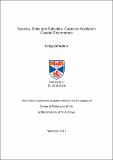Files in this item
Sources, sinks and subsidies : carbon in Scotland's coastal environments
Item metadata
| dc.contributor.advisor | Austin, William | |
| dc.contributor.advisor | Davies, Althea | |
| dc.contributor.advisor | Howe, John A. | |
| dc.contributor.author | Smeaton, Craig | |
| dc.coverage.spatial | 261 | en_US |
| dc.date.accessioned | 2019-03-28T16:30:24Z | |
| dc.date.available | 2019-03-28T16:30:24Z | |
| dc.date.issued | 2018 | |
| dc.identifier.uri | https://hdl.handle.net/10023/17397 | |
| dc.description.abstract | The rise of anthropogenic carbon dioxide concentrations in the atmosphere has forced a revaluation of our current understanding of the magnitude and mechanisms which govern natural carbon pools around the world. A largely overlooked carbon pool is held within the sediments of the world’s oceans with the coastal oceans potentially playing a globally significant role in climate regulation. These marine sedimentary environments and fjords in particular are recognised as hotspots for the burial of carbon, yet little is known about the quantity of carbon held within such environments. In this study, we use the mid-latitude fjords of Scotland as a natural laboratory to develop new methodologies to quantify marine sedimentary C stores and better understand how these stores develop through time with a specific focus on the long-term linkages with the terrestrial environment. The newly developed methodology has allowed for the first time the quantification of a national marine sedimentary carbon stock. The sediments within these mid-latitude fjords hold a quantity of carbon comparable in magnitude to most terrestrial environments in Scotland. However, when area-normalised comparisons are made, these mid-latitude fjords are significantly more effective as C stores than their terrestrial counterparts, including Scottish peatlands. Additionally; our understanding of the long-term role of the terrestrial environment in the development of these systems has been significantly improved with it being estimate that approximately half the carbon held within Scottish fjords is terrestrial in origin. Through the Holocene fjordic sediments have been shown too adapted to increased carbon input through increasing the rate at which carbon in buried, going forward this will be highly significant in mitigating the impact of predicated climatic and human induced environmental change. This project has highlighted the importance of understanding carbon held within marine and coastal sediments. By increasing our understanding of such coastal sedimentary carbon stores we will be better able to estimate the global carbon burial rates and storage further constraining the their role in the global carbon cycle. | en_US |
| dc.language.iso | en | en_US |
| dc.publisher | University of St Andrews | en |
| dc.subject.lcc | QH141.S6 | |
| dc.subject.lcsh | Coasts--Scotland | en |
| dc.subject.lcsh | Environmental policy--Scotland | en |
| dc.subject.lcsh | Environmental protection--Scotland | en |
| dc.title | Sources, sinks and subsidies : carbon in Scotland's coastal environments | en_US |
| dc.type | Thesis | en_US |
| dc.type.qualificationlevel | Doctoral | en_US |
| dc.type.qualificationname | PhD Doctor of Philosophy | en_US |
| dc.publisher.institution | The University of St Andrews | en_US |
This item appears in the following Collection(s)
Items in the St Andrews Research Repository are protected by copyright, with all rights reserved, unless otherwise indicated.

